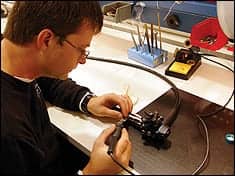Human nature being what it is, it is generally much easier for us to react. We don’t have to think about removing our hand once it is on a hot surface, although it would have required at least some effort to decide whether we should put it there in the first place. Yet in hindsight, who would disagree that it would have been worth some forethought to avoid that burn? In this case, the cost of our complacency (our willingness to proceed as usual without sufficient consideration of evolving dangers and deficiencies) was the burn.
With respect to healthcare technology, I fear the cost of what I see as our current complacency could be patient care that is less safe, less effective, and considerably costlier.
Don’t get me wrong. I believe our technological advances have the potential to greatly improve the quality of healthcare and widely extend its availability to a higher percentage of this country’s and the world’s population at ever lower costs.
However, I also see a conundrum. I know that the mere existence of our technological advances, regardless of how complex or sophisticated, does not guarantee a beneficial result. Ultimately, achieving the hoped-for benefits of our evolving technologies depends on how new technological advances are used and how effectively they are supported. If we remain complacent—if we fail to adapt how we use and support new healthcare technologies—we will get burned by growing safety issues, ineffective care, and higher costs. Just consider the growing number of problems we hear of related to systemic technology failures (eg, failed servers “taking down” tens or hundreds of devices, staff subjected to alarm or alert overloads, patients injured by inadequately skilled operators of increasingly sophisticated equipment), and the expensive technology “orphans” created when their only sponsors depart.
When I began my career in clinical engineering over 40 years ago, our challenges were much simpler. We dealt with discrete medical devices. We made sure the new medical equipment acquired by the hospital was safe, that it was tested routinely to ensure “wear and tear” issues were fixed before they led to failure, and that failing medical equipment was repaired safely and at a reasonable cost. For the first 20 to 25 years of my career, that approach made sense and seemed to satisfactorily address the healthcare technology issue.
But especially in the past 15 to 20 years, the nature of healthcare technology has been rapidly changing. Increasingly, medical equipment is miniaturized, microprocessor-based, networked, and created by assembling systems of systems. Today’s equipment is much less electromechanical, and therefore much less subject to wear and tear. When they do occur, failures are usually of a spontaneous type that no reasonable amount of scheduled maintenance could have predicted or prevented. Rather, a growing number of failures are likely to be related to poor equipment planning, ineffective use, poor process design, integration or communication failures, ineffective data security, and misconfiguration issues.
Yet while healthcare technology has continued to rapidly evolve and new vulnerabilities continue to arise, the vast majority of healthcare technology management (HTM) programs remain slow to respond. As a result, they have changed little from their traditional emphasis on inspection and repair. There has been a failure to imagine changes in HTM roles paralleling the very real changes that have taken place in the healthcare technology that HTM is supposed to be supporting. At best, this failure to imagine has led to the complacency of many HTM programs, and has marginalized them and made them increasingly irrelevant. At worst, their complacency leads to an unsafe environment, poor care, and costly implementations of technology.
How do we ensure HTM’s relevance and avoid complacency and its undesirable consequences? First, we need to recognize that while many new healthcare technologies have great potential, they may not be appropriate for every situation at every provider—or at least, there may be a right time and a wrong time for their implementation. Healthcare providers should take a calculated approach when considering if and when to deploy new medical systems. They should establish reasonable expectations about the benefits they hope to achieve and the timetable in which they hope to achieve them. Providers should also have adequate resources to get the results they expect from new technology implementations, including sufficient technical support at a reasonable cost. If HTM is to remain relevant, departments must step up and help providers establish an effective process for technology acquisition, and they must prepare themselves to serve as a key advisor in that process once it is established.
Next, our industry needs to recognize that HTM must have new processes, partnerships, roles, skill sets, and tools to support existing and future generations of healthcare technology. Today, this means that there must be close collaboration between HTM, IT, and vendors on a growing range of technology management processes. The framework of many of these collaborative processes can be found in technology service management standards such as ITIL v3 and ISO 20000 and other standards such as ANSI/AAMI/IEC 80001 on the Application of risk management for IT Networks incorporating medical devices.
HTM also must complement its traditional capabilities and roles by arming itself with new professionals and new expertise in systems management and integration, risk and security management, service analytics, incident and problem management, change management, configuration management, and continuity management, among others. HTM must also actively work with clinicians, IT, risk management, supply chain, finance, vendors, and other stakeholders to ensure the aforementioned services are delivered effectively.
Finally, our industry needs to consciously swear off complacency and accept that change is the new norm. Advances in healthcare and healthcare technology are occurring at an exponential rate. Our only hope of meeting the challenges associated with these advances is to apply liberal amounts of imagination as we formulate our plans to adapt our services to those challenges.
Constantly and successfully adapting to the changing environment is the key to our success. Ultimately, the cost of complacency is not only an unsafe environment, compromised care, and high cost, but our own obsolescence. It is our choice.
Stephen Grimes is managing partner at Strategic Healthcare Technology Associates LLC. For more information, contact chief editor Jenny Lower at [email protected].







Great article, Mr. Grimes. I find your point on HTM role in equipment acquisition process particularly important and also one of the most challenging for most HTM departments nowdays.
Complacency 1. a feeling of quiet pleasure or security, often while unaware of some potential danger, defect, or the like; self-satisfaction or smug satisfaction with an existing situation, condition, etc.
For me, our industry’s CE leadership failing to recognize and take a stand against OEMs that are failing to provide factory service manuals and sell service parts to biomeds is one of the most serious symptoms of the complacency Mr Grimes speaks of. Today I had to pack and ship an ultrasonic generator across the country for a minor repair. The OEM would not comply with the service manuals requirements of NFPA-99. Nor would they sell me the parts even if I did have factory manual that had the alignment and calibration procedure for the oscillator PCB that failed. In the time I had to spend to find a box, pack it up, etc.. I could have easily did the repair, but now I can expect an estimated $4000+ repair bill from the OEM.
Complacency has a cost. Our industry and its leaders really need to do a much better job on supporting the right to repair issue. Or soon our country’s clinical engineering degree programs will be teaching their students courses like “advanced packing and shipping,” “UPS 101,” and “fundamentals of tape gun maintenance.”
Next time a salesman presents a device to your department for a DEMO sticker, be sure and inspect the device’s factory service manual at the 1st phase of the inspection, let the salesman know that his company will be required to sell you service parts and provide passwords as part of the purchase. Let them know service business is some thing the company may be allowed to earn, not mandate.
Complacency, yes, it’s a bad thing.
J Scot Mackeil CBET Boston Ma.